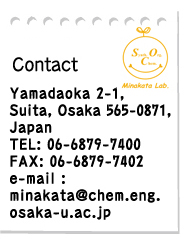home > Pablication
2017 2016 2015 2014 2013 2012 2011 2010
2009 2008 1998–2007
“Iodine-Catalyzed Stereospecific anti-Diamination of trans-β-Methylstyrene"
Takeshi Sugiyama, Chiyuki Naito, and Satoshi Minakata*
Org. Synth. 2025, 102, 203–216. DOI:10.15227/orgsyn.102.0203

Abstract: In this study, we developed an environmentally friendly synthetic method that achieves the stereospecific anti-diamination of trans-β-methylstyrene with high selectivity and yield, utilizing an iodine catalyst and sodium hypochlorite pentahydrate.
“Photoinduced Azidoamination of Styrenes Using Sodium Azide and (Diphenylmethylene)amino Benziodoxolone"
Kensuke Kiyokawa*, Koki Nakano, Daichi Okumura, and Satoshi Minakata*
Chem. Asian J. 2025, 20, e202401493/1–4. DOI:10.1002/asia.202401493






